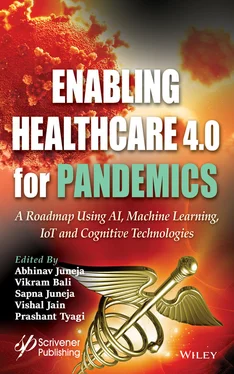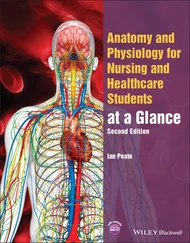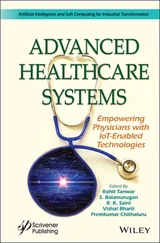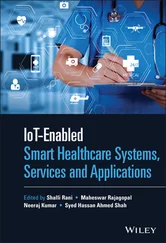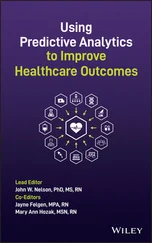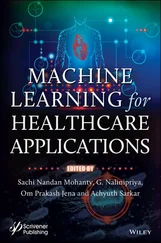1 Cover
2 Title page
3 Copyright
4 Preface
5 Part 1 MACHINE LEARNING FOR HANDLING COVID-19 1 COVID-19 and Machine Learning Approaches to Deal With the Pandemic 1.1 Introduction 1.2 COVID-19 Diagnosis in Patients Using Machine Learning 1.3 AI and Machine Learning as a Support System for Robotic System and Drones 1.4 Conclusion References 2 Healthcare System 4.0 Perspectives on COVID-19 Pandemic 2.1 Introduction 2.2 Key Techniques of HCS 4.0 for COVID-19 2.3 Real World Applications of HCS 4.0 for COVID-19 2.4 Opportunities and Limitations 2.5 Future Perspectives 2.6 Conclusion References 3 Analysis and Prediction on COVID-19 Using Machine Learning Techniques 3.1 Introduction 3.2 Literature Review 3.3 Types of Machine Learning 3.4 Machine Learning Algorithms 3.5 Analysis and Prediction of COVID-19 Data 3.6 Analysis Using Machine Learning Models 3.7 Conclusion & Future Scope References 4 Rapid Forecasting of Pandemic Outbreak Using Machine Learning 4.1 Introduction 4.2 Effect of COVID-19 on Different Sections of Society 4.3 Definition and Types of Machine Learning 4.4 Machine Learning Approaches for COVID-19 References 5 Rapid Forecasting of Pandemic Outbreak Using Machine Learning: The Case of COVID-19 5.1 Introduction 5.2 Related Work 5.3 Suggested Methodology 5.4 Models in Epidemiology 5.5 Particle Filtering Algorithm 5.6 MCM Model Implementation 5.7 Diagnosis of COVID-19 5.8 Conclusion References
6 Part 2 EMERGING TECHNOLOGIES TO DEAL WITH COVID-19 6 Emerging Technologies for Handling Pandemic Challenges 6.1 Introduction 6.2 Technological Strategies to Support Society During the Pandemic 6.3 Feasible Prospective Technologies in Controlling the Pandemic 6.4 Coronavirus Pandemic: Emerging Technologies That Tackle Key Challenges 6.5 The Golden Age of Drone Delivery 6.6 Technology Helps Pandemic Management 6.7 Conclusion References 7 Unfolding the Potential of Impactful Emerging Technologies Amid COVID-19 7.1 Introduction 7.2 Review of Technologies Used During the Outbreak of Ebola and SARS 7.3 Emerging Technological Solutions to Mitigate the COVID-19 Crisis 7.4 Conclusion References 8 Advances in Technology: Preparedness for Handling Pandemic Challenges 8.1 Introduction 8.2 Issues and Challenges Due to Pandemic 8.3 Digital Technology and Pandemic 8.4 Application of Technology for Handling Pandemic 8.5 Challenges with Digital Healthcare 8.6 Conclusion References 9 Emerging Technologies for COVID-19 9.1 Introduction 9.2 Related Work 9.3 Technologies to Combat COVID-19 9.4 Comparison of Various Technologies to Combat COVID-19 9.5 Conclusion References 10 Emerging Techniques for Handling Pandemic Challenges 10.1 Introduction to Pandemic 10.2 Technique Used to Handle Pandemic Challenges 10.3 Working Process of Techniques 10.4 Data Analysis 10.5 Rapid Development Structure 10.6 Conclusion & Future Scope References
7 Part 3 ALGORITHMIC TECHNIQUES FOR HANDLING PANDEMIC 11 A Hybrid Metaheuristic Algorithm for Intelligent Nurse Scheduling 11.1 Introduction 11.2 Methodology 11.3 Computational Results 11.4 Conclusion References 12 Multi-Purpose Robotic Sensing Device for Healthcare Services 12.1 Introduction 12.2 Background and Objectives 12.3 The Functioning of Multi-Purpose Robot 12.4 Discussion and Conclusions References 13 Prevalence of Internet of Things in Pandemic 13.1 Introduction 13.2 What is IoT? 13.3 Various Models Proposed for Managing a Pandemic Like COVID-19 Using IoT 13.4 Global Technological Developments to Overcome Cases of COVID-19 13.5 Results & Discussions 13.6 Conclusion References 14 Mathematical Insight of COVID-19 Infection—A Modeling Approach 14.1 Introduction 14.2 Epidemiology and Etiology 14.3 Transmission of Infection and Available Treatments 14.4 COVID-19 Infection and Immune Responses 14.5 Mathematical Modeling 14.6 Conclusion References 15 Machine Learning: A Tool to Combat COVID-19 15.1 Introduction 15.2 Our Contribution 15.3 State-Wise Data Set and Analysis 15.4 Neural Network 15.5 Results and Discussion 15.6 Conclusion 15.7 Future Scope References
8 Index
9 End User License Agreement
1 Cover
2 Table of Contents
3 Series page
4 Title page
5 Copyright
6 Preface
7 Begin Reading
8 Index
9 End User License Agreement
1 Chapter 1 Figure 1.1 Confirmed cases in top 3 countries in the number of cases (Cumulative... Figure 1.2 Diagnosis of COVID-19 using support vector based machine learning app... Figure 1.3 Machine learning process for drug development. Figure 1.4 Machine learning approach for reuse of drug in COVID-19.
2 Chapter 3 Figure 3.1 A typical linear regression graph. Figure 3.2 Multiple linear regression graph. Figure 3.3 Logistic regression graph. Figure 3.4 Decision tree graph. Figure 3.5 Workflow of the present study. Figure 3.6 States with confirmed cases of COVID-19. Figure 3.7 Comparing cases w.r.t. gender. Figure 3.8 Observed cases vs dates. Figure 3.9 Age group vs COVID-19. Figure 3.10 States with number of primary healthcare centers. Figure 3.11 State wise confirmed/cured/death cases of COVID-19. Figure 3.12 Comparison of accuracy of different models.
3 Chapter 4Figure 4.1 Machine Learning & its types.Figure 4.2 Binary classification.Figure 4.3 Multi-class classification.Figure 4.4 Steps followed in text classification process.
4 Chapter 5Figure 5.1 Illustration of Back propagation [20].Figure 5.2 Correlation between health predictive analysis and epidemic disease f...
5 Chapter 6Figure 6.1 Emerging technologies for pandemic situations.Figure 6.2 The general procedure of AI and non-AI based applications.
6 Chapter 7Figure 7.1 Total confirmed cases of top 10 worst-hit countries.Figure 7.2 The classification of Emerging Technologies.
7 Chapter 8Figure 8.1 Impact of COVID-19 on health.Figure 8.2 Global economy impact due to COVID-19.Figure 8.3 Role of digital technology during pandemic.Figure 8.4 Daily cases from 15 April to July 2020.Figure 8.5 New cases predicted for August 2020 based on training data from April...Figure 8.6 Recovery prediction for August based on the training set from April t...Figure 8.7 Death prediction for August based on the training set from April to J...
8 Chapter 9Figure 9.1 Some ingenious technologies to fight against COVID-19.Figure 9.2 Blockchain and AI for battling against COVID-19.Figure 9.3 Aarogya Setu Mobile App.
9 Chapter 10Figure 10.1 Face mask detection from group of people.Figure 10.2 Face mask detections.Figure 10.3 Smart sanitizations.Figure 10.4 COVID-19 tracking applications.Figure 10.5 Occupancy representation systems.Figure 10.6 Total sample and positive cases in Haryana.Figure 10.7 Increment rate in Haryana.Figure 10.8 Total sample and positive cases in Punjab.Figure 10.9 Increment rate in Punjab.Figure 10.10 Total sample and positive cases in Uttar Pradesh.Figure 10.11 Increment rate in Uttar Pradesh.Figure 10.12 Total sample and positive cases in Rajasthan.Figure 10.13 Increment rate in Rajasthan.Figure 10.14 Total sample and positive cases in Bihar.Figure 10.15 Increment rate in Bihar.Figure 10.16 Total sample and positive cases in Delhi.Figure 10.17 Increment rate in Delhi.Figure 10.18 Total sample and positive cases in Gujarat.Figure 10.19 Increment rate in Gujarat.Figure 10.20 Total sample and positive cases in Madhya Pradesh.Figure 10.21 Increment rate in Madhya Pradesh.Figure 10.22 Total sample and positive cases in Maharashtra.Figure 10.23 Increment rate in Maharashtra.Figure 10.24 Proposed rapid development structure.
10 Chapter 11Figure 11.1 Pseudocode of APGWO.Figure 11.2 One-point crossover operation.Figure 11.3 Two-point crossover operation.Figure 11.4 Creating a neighborhood solution.
11 Chapter 12Figure 12.1 UV disinfection robot.Figure 12.2 Telepresence robot.Figure 12.3 Disinfection robot.Figure 12.4 Surgery assisting robot.Figure 12.5 Neurosurgery assisting robot.
Читать дальше
